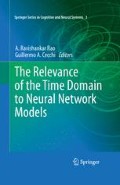Abstract
The field of neural modeling uses neuroscientific data and measurements to build computational abstractions that represent the functioning of a neural system. The timing of various neural signals conveys important information about the sensory world, and also about the relationships between activities occurring in different parts of a brain. Both theoretical and experimental advances are required to effectively understand and model such complex interactions within a neural system. This book aims to develop a unified understanding of temporal interactions in neural systems, including their representation, role and function. We present three different research perspectives arising from theoretical, engineering and experimental approaches.
Access this chapter
Tax calculation will be finalised at checkout
Purchases are for personal use only
References
Berdyyeva TK, Reynolds JH (2009) The dawning of primate optogenetics. Neuron 62(2):159–160
Cardin JA et al. (2009) Driving fast-spiking cells induces gamma rhythm and controls sensory responses. Nature 459(7247):663–667
Dave AS, Margoliash D (2000) Song replay during sleep and computational rules for sensorimotor vocal learning. Science 290:812–816
Fries P et al. (2001) Modulation of oscillatory neuronal synchronization by selective visual attention. Science 291(5508):1560–1563
Gray CM et al. (1989) Oscillatory responses in cat visual cortex exhibit inter-columnar synchronization which reflects global stimulus properties. Nature 338:334–337
Haider B, McCormick DA (2009) Rapid neocortical dynamics: cellular and network mechanisms. Neuron 62(2):171–189
Han X et al. (2009) Millisecond-timescale optical control of neural dynamics in the nonhuman primate brain. Neuron 62(2):191–198
Jefferys JGR, Traub RD, Whittington MA (1996) Neuronal networks for induced ‘40 Hz’ rhythms. Trends Neurosci 19:202–208
Joliot M, Ribary U, Llinás R (1994) Human oscillatory brain activity near 40 Hz coexists with cognitive temporal binding. Proc Natl Acad Sci USA 91(24):11748–11751
Kuramoto Y (1984) Chemical oscillations, waves, and turbulence. Springer, Berlin
Liu H et al. (2009) Timing, timing, timing: fast decoding of object information from intracranial field potentials in human visual cortex. Neuron 62(2):281–290
Rodriguez E et al. (1999) Perception’s shadow: long-distance synchronization of human brain activity. Nature 397:430–433
von der Malsburg C (1999) The what and why of binding: the modeler’s perspective. Neuron 24:95–104
Wilson MA, McNaughton BL (1994) Reactivation of hippocampal ensemble memories during sleep. Science 265:676–679
Winfree AT (2001) The geometry of biological time, 2nd edn. Springer, Berlin
Author information
Authors and Affiliations
Corresponding author
Editor information
Editors and Affiliations
Rights and permissions
Copyright information
© 2012 Springer Science+Business Media, LLC
About this chapter
Cite this chapter
Cecchi, G., Rao, A.R. (2012). Introduction. In: Rao, A., Cecchi, G. (eds) The Relevance of the Time Domain to Neural Network Models. Springer Series in Cognitive and Neural Systems, vol 3. Springer, Boston, MA. https://doi.org/10.1007/978-1-4614-0724-9_1
Download citation
DOI: https://doi.org/10.1007/978-1-4614-0724-9_1
Publisher Name: Springer, Boston, MA
Print ISBN: 978-1-4614-0723-2
Online ISBN: 978-1-4614-0724-9
eBook Packages: Biomedical and Life SciencesBiomedical and Life Sciences (R0)

